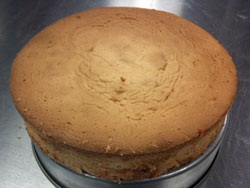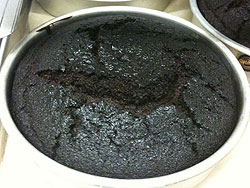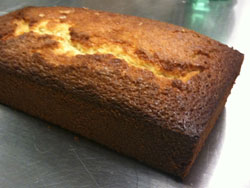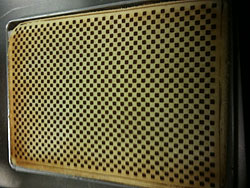Cakes Week One
Cakes are a sweet variation of bread that is believed to first appeared in Greek and Roman society. In 1956 cake flour was invented by using a soft winter wheat.
The base for cake is usually a sponge, consisting of its most basic form of sugar, eggs, and flour. A heavy cake has equal parts of the ingredients, like pound cake. A medium cake has less flour and sugar than eggs, like a typical sheet cake. A light cake has very little flour, more egg whites and more sugar, like an angel food cake. A higher amount of egg whites will result in a lighter sponge with a bigger crumb (holes in the cake). The higher the egg yolks the denser the sponge with smaller holes (crumb). If too little sugar is used it will affect the taste, color, and texture of the sponge, making it darker and dense.
When mixing a cake the flour should be folded into the wet ingredients until it is just combined. This ensures the gluten is not overdeveloped which could result in a dense rubbery sponge. Cake flour falls as it cools, turning your cake upside down to cool will help flatten out the top of the cake. Vanilla and other liquid flavorings should be added to the wet mixture before folding in the flour mixture. Butter is sometimes used for flavor and extending the shelf life of the finished product. Melted butter that is close to room temperature should be added after the flour is folded in. Fruit and nuts should be added in at the end.
To use nut flour with regular flour, replace one ounce of flour for every three ounces of nut flour added. The quantity of nut flour cannot exceed the weight of the sugar in the recipe.
The sifted cocoa powder can be added for flavor with the dry ingredients. It should not exceed the weight of the flour and no more than three ounces per pound of flour. Unsweetened chocolate can be added to flavor with no more than five ounces per pound of flour. If using sweetened chocolate reduce the sugar by two ounces per pound of sugar. Fold the melted chocolate in after the flour in three stages, with the first fold being only a small amount.
There are two common methods of making cakes, the warm and the cold method. In the warm method eggs and sugar are combined over a water bath until all the sugar dissolves. The eggs and sugar are then whipped on high until ribbon stage and then the dry ingredients are folded in. Sometimes melted butter or oil are added after the folding to produce a more moist cake. The fat in butter also acts as a preservative prolonging the shelf life of the cake. If no fat is added the cack usually must is moistened with a glaze. A common type of warm cake is a genoise.
The cold method is a separated egg sponge. Egg yolks are whipped with sugar and set aside. The egg whites are whipped with sugar to a specified peak and then folded into the egg yolk mixture along with the dry ingredients. This creates a lighter and sweater sponge than the warm method. Common cold method cakes are angel food cake and chiffon cake.
Both methods produce a cake that has finished baking when a toothpick inserted into the center of the cake is clean when removed, or the middle of the cake springs back when touched. When baking sponge of either method the pan should not be greased, this ensures the cake will raise up the side of the pan and not fall. Parchment on the bottom of the pan will ensure minimal sticking. Use a small knife to remove the cake from the sides of the pan. If you modify a recipe and are afraid it won’t raise properly you can add up to two teaspoons of baking powder for every 12 eggs used. Don’t use baking soda, you will need to add an acid to your recipe for it to work.
Cakes are generally baked between 350° and 400°. When using a cake recipe for cupcakes increase the temperature and decrease the total baking time. Likewise when using a cupcake recipe and converting it to a cake recipe decrease the temperature and increase the baking time. Cooling either type of sponge is part of the baking process and should be allowed to complete before serving or decorating.
Tools
- Offset Spatula
- Icing Spatula
- Pastry Cutter
- Cake Stand
- Digital Scale
- Pastry bags, coupler, and tips
- Cake Boards
Heres what we made this week (only the Lemon Cake was finished, the other cakes will be used in the coming weeks):

 Chiffon Sponge
Chiffon Sponge Jeff’s Chocolate Birthday Cake
Jeff’s Chocolate Birthday Cake Lemon Pound Cake
Lemon Pound Cake Patterned Jaconde Sponge
Patterned Jaconde Sponge